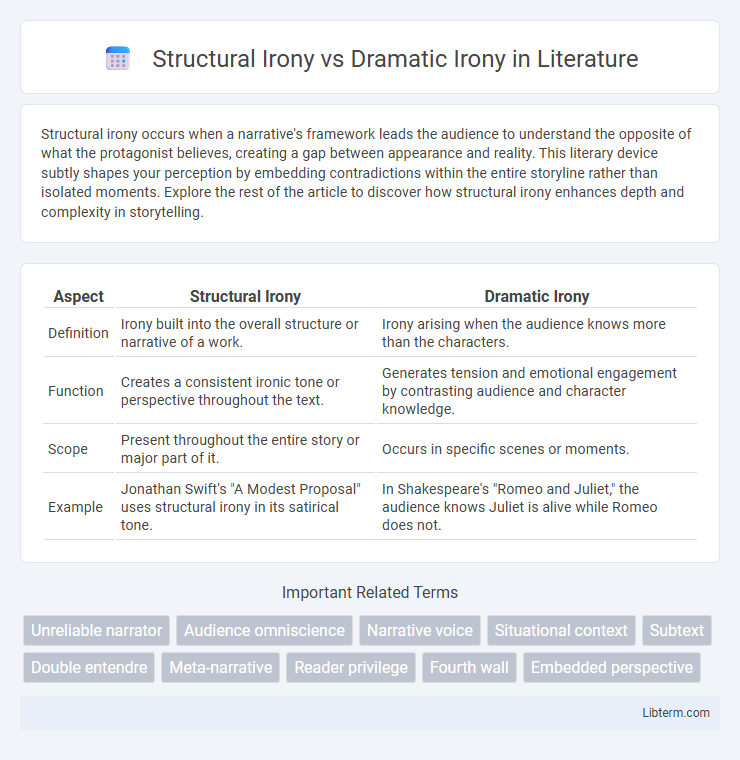Structural irony occurs when a narrative's framework leads the audience to understand the opposite of what the protagonist believes, creating a gap between appearance and reality. This literary device subtly shapes your perception by embedding contradictions within the entire storyline rather than isolated moments. Explore the rest of the article to discover how structural irony enhances depth and complexity in storytelling.
Table of Comparison
| Aspect | Structural Irony | Dramatic Irony |
|---|---|---|
| Definition | Irony built into the overall structure or narrative of a work. | Irony arising when the audience knows more than the characters. |
| Function | Creates a consistent ironic tone or perspective throughout the text. | Generates tension and emotional engagement by contrasting audience and character knowledge. |
| Scope | Present throughout the entire story or major part of it. | Occurs in specific scenes or moments. |
| Example | Jonathan Swift's "A Modest Proposal" uses structural irony in its satirical tone. | In Shakespeare's "Romeo and Juliet," the audience knows Juliet is alive while Romeo does not. |
Introduction to Irony in Literature
Structural irony in literature involves a sustained discrepancy between a narrator's understanding and the actual truth, often shaping a story's tone or theme throughout the entire work. Dramatic irony occurs when the audience possesses knowledge that characters lack, creating tension or humor as characters act unaware of critical facts. Both forms of irony enrich narratives by layering meaning and engaging readers through contrasting perspectives.
Defining Structural Irony
Structural irony is a sustained form of irony embedded throughout a narrative, where a naive or unreliable protagonist consistently misinterprets events, creating a gap between the character's understanding and the audience's awareness. This prolonged mismatch shapes the entire story's meaning, contrasting sharply with dramatic irony, which occurs when the audience knows critical information unknown to the characters at specific moments. Structural irony thus operates on a broader narrative level, influencing tone and theme through persistent character misconceptions.
Defining Dramatic Irony
Dramatic irony occurs when the audience possesses knowledge that characters in the narrative do not, creating a tension between the character's perception and the actual situation. This form of irony enhances suspense and emotional engagement by allowing viewers to anticipate the consequences of characters' actions based on information they lack. Structural irony, contrastingly, spans the entire narrative, with an underlying disparity between the protagonist's understanding and the reality the audience perceives.
Key Differences Between Structural and Dramatic Irony
Structural irony involves a consistent discrepancy between a character's perspective and the true situation throughout an entire narrative, often achieved through an unreliable narrator, while dramatic irony occurs when the audience possesses knowledge that the characters lack, creating tension or humor in specific scenes. Structural irony shapes the overall framework of a story, highlighting contradictions in worldview or understanding, whereas dramatic irony is confined to particular moments where audience awareness contrasts with character ignorance. The key difference lies in structural irony's sustained narrative technique versus dramatic irony's localized, scene-based revelation.
Functions of Structural Irony in Storytelling
Structural irony functions in storytelling by creating a sustained discrepancy between the protagonist's understanding and the actual reality, often leading to a deeper thematic exploration and complex character development. This form of irony subtly guides the audience to perceive the underlying contradictions and moral ambiguities embedded in the narrative. By maintaining this ironic framework, structural irony encourages critical reflection and highlights the limitations of the character's perspective within the broader context of the plot.
The Role of Dramatic Irony in Plot Development
Dramatic irony intensifies plot development by creating tension and engagement as the audience possesses critical knowledge unknown to the characters, influencing their decisions and actions. This form of irony deepens emotional resonance and foreshadows pivotal turning points, enhancing narrative complexity and suspense. In contrast, structural irony encompasses the broader thematic use of irony throughout a work, while dramatic irony specifically drives immediate plot dynamics and viewer investment.
Examples of Structural Irony in Classic Literature
Structural irony is exemplified in classic literature through works like Jonathan Swift's "Gulliver's Travels," where the narrator's naive perspective creates a persistent irony contrasting the revealed truths and his limited understanding. In Henry James' "The Turn of the Screw," the unreliable governess's narrative fosters structural irony by causing readers to question the reality of the ghosts she perceives. These examples illustrate how structural irony sustains an overarching layer of meaning, shaping the reader's interpretation beyond isolated events, unlike dramatic irony which hinges on audience knowledge versus character ignorance in specific scenes.
Examples of Dramatic Irony in Famous Works
Examples of dramatic irony in famous works include Shakespeare's "Romeo and Juliet," where the audience knows Juliet is alive despite Romeo's belief that she is dead, leading to tragic consequences. In Sophocles' "Oedipus Rex," viewers are aware of Oedipus' true parentage long before he realizes it himself, heightening the tension as he unknowingly fulfills the prophecy. These instances of dramatic irony engage the audience by creating a gap between the characters' knowledge and the audience's awareness, intensifying emotional impact and suspense.
Impact of Irony Types on Reader Experience
Structural irony creates sustained tension by embedding an overarching discrepancy between reality and perception throughout the narrative, leading readers to question the reliability of the protagonist's perspective and enhancing thematic depth. Dramatic irony intensifies emotional engagement by allowing readers privileged knowledge about characters' fates or true situations, generating suspense and a poignant sense of anticipation or dread. Both irony types enrich the reader's interpretive experience, with structural irony fostering critical reflection and dramatic irony amplifying emotional resonance.
Conclusion: Choosing the Right Irony for Your Narrative
Selecting between structural irony and dramatic irony hinges on the narrative's purpose and audience engagement. Structural irony weaves sustained ambiguity into the fabric of the story, offering a pervasive layer of meaning that challenges readers' interpretations. Dramatic irony, by contrast, leverages audience knowledge to heighten tension and emotional impact, making it ideal for creating suspense or deepening character dynamics.
Structural Irony Infographic

 libterm.com
libterm.com